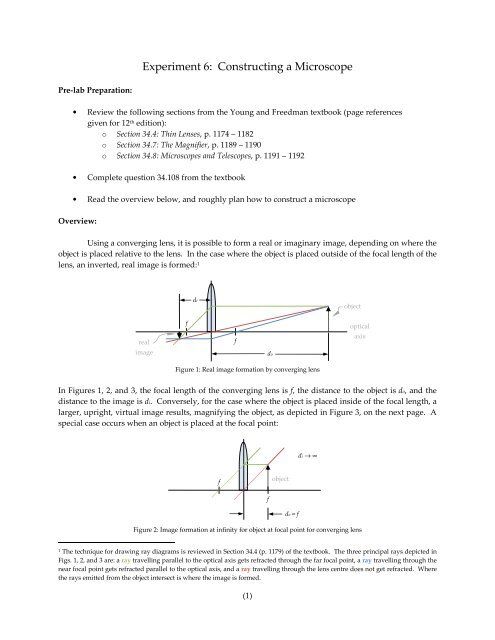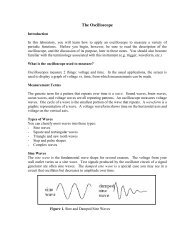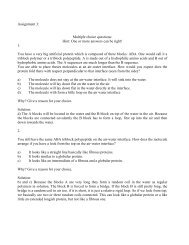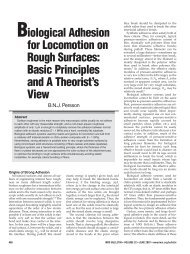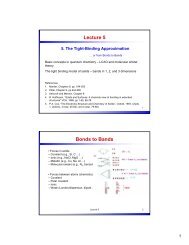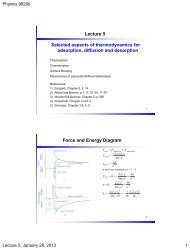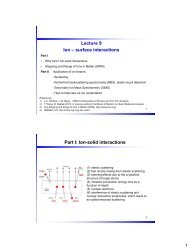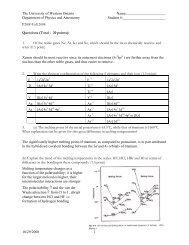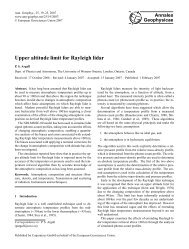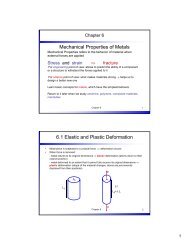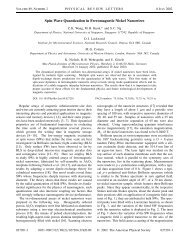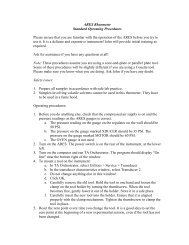Experiment 6: Constructing a Microscope
Experiment 6: Constructing a Microscope
Experiment 6: Constructing a Microscope
Create successful ePaper yourself
Turn your PDF publications into a flip-book with our unique Google optimized e-Paper software.
<strong>Experiment</strong> 6: <strong>Constructing</strong> a <strong>Microscope</strong><br />
Pre-lab Preparation:<br />
• Review the following sections from the Young and Freedman textbook (page references<br />
given for 12 th edition):<br />
o Section 34.4: Thin Lenses, p. 1174 – 1182<br />
o Section 34.7: The Magnifier, p. 1189 – 1190<br />
o Section 34.8: <strong>Microscope</strong>s and Telescopes, p. 1191 – 1192<br />
• Complete question 34.108 from the textbook<br />
• Read the overview below, and roughly plan how to construct a microscope<br />
Overview:<br />
Using a converging lens, it is possible to form a real or imaginary image, depending on where the<br />
object is placed relative to the lens. In the case where the object is placed outside of the focal length of the<br />
lens, an inverted, real image is formed: 1<br />
di<br />
object<br />
real<br />
image<br />
f<br />
f<br />
do<br />
optical<br />
axis<br />
Figure 1: Real image formation by converging lens<br />
In Figures 1, 2, and 3, the focal length of the converging lens is f, the distance to the object is do, and the<br />
distance to the image is di. Conversely, for the case where the object is placed inside of the focal length, a<br />
larger, upright, virtual image results, magnifying the object, as depicted in Figure 3, on the next page. A<br />
special case occurs when an object is placed at the focal point:<br />
di → ∞<br />
f<br />
object<br />
f<br />
do = f<br />
Figure 2: Image formation at infinity for object at focal point for converging lens<br />
1<br />
The technique for drawing ray diagrams is reviewed in Section 34.4 (p. 1179) of the textbook. The three principal rays depicted in<br />
Figs. 1, 2, and 3 are: a ray travelling parallel to the optical axis gets refracted through the far focal point, a ray travelling through the<br />
near focal point gets refracted parallel to the optical axis, and a ray travelling through the lens centre does not get refracted. Where<br />
the rays emitted from the object intersect is where the image is formed.<br />
(1)
virtual<br />
image<br />
object<br />
f<br />
do<br />
f<br />
di<br />
Figure 3: Virtual image formation by converging lens<br />
When the object is located at the converging lens’ focal point, as in Figure 2, the rays forming the image<br />
are parallel; thus, an image of infinite linear magnification is formed. This behaviour is quantified by the<br />
thin lens equation, relating the object distance, do, the image distance, di, and the focal length of the lens:<br />
1 1 1<br />
= +<br />
(1)<br />
f d<br />
0<br />
d i<br />
This equation is derived in Young and Freedman, 12 th Edition, p. 1174 – 1175 using a similar triangles argument.<br />
The sign convention used by the textbook stipulates that f > 0 for a converging lens, and di > 0 if<br />
the image is formed on the opposite side of the lens as the object (i.e. a real image). The behaviour in Figure<br />
1 is observed if do > f, giving di > 0. Conversely, if do < f, then di < 0, giving the virtual image illustrated<br />
in Figure 2. Finally, if do = f, then di → ∞ to give 1/di = 0.<br />
Next, two types of magnification may be defined: the linear (or lateral) magnification, and the angular<br />
magnification. The linear magnification, m, is the negative ratio of the object’s height to the image’s<br />
height:<br />
hi<br />
m = −<br />
h<br />
o<br />
Making use of similar triangles in the previous figures gives that the linear magnification is also the ratio<br />
of the image distance to the object distance:<br />
m<br />
d<br />
d<br />
i<br />
= −<br />
(2)<br />
o<br />
If one solves for di in the thin lens equation, Eq. (1), and substitutes it into the expression for lateral magnification,<br />
Eq. (2), then:<br />
f<br />
m = (3)<br />
f −<br />
d o<br />
(2)
Hence, if an object is placed at the focal point, do = f, the lateral magnification approaches infinity, as noted<br />
earlier. It’s clear, however, that placing an object at the focal point of a magnifying glass does not produce<br />
an image of the object that’s infinitely large, so an alternate measure of magnification must be defined.<br />
This is where the angular magnification is useful. The angular magnification, M, is defined as the<br />
ratio of the angles subtended by the object and its magnified image:<br />
θo<br />
object<br />
f<br />
θi<br />
d<br />
(usually defined<br />
as d = 25 cm)<br />
parallel rays<br />
focused by eye<br />
f<br />
object<br />
Figure 4: Comparison of angle subtended by object and magnified object<br />
θi<br />
M =<br />
θ<br />
o<br />
−1<br />
tan ( ho<br />
=<br />
−1<br />
tan ( h<br />
o<br />
/ f )<br />
/ d)<br />
For small angles θo and θi, tanθo ≈ θo and tanθi ≈ θi, leaving the following expression for the angular magnitude:<br />
d<br />
M = (4)<br />
f<br />
For convenience and consistency, most microscopes define angular magnification with d = 25 cm, the<br />
minimum distance from the eye at which objects can be resolved for most people. It can be seen that, in<br />
principle, as the focal length approaches zero, the angular magnification approaches infinity. The magnification<br />
is actually limited by effects such as wavelength-dependent index of refraction and irregularities<br />
in the shape of the lens that make the image irresolvable for M > 5 or so. To address this, a compound<br />
microscope, making use of two converging lenses, is constructed:<br />
eyepiece<br />
Do<br />
di<br />
f<br />
F<br />
objective lens<br />
f<br />
do<br />
Di<br />
Figure 5: Sample microscope apparatus<br />
(3)
Do<br />
eyepiece<br />
F<br />
di<br />
f<br />
objective lens<br />
f<br />
do<br />
Di → ∞<br />
Figure 6: Alternate sample microscope<br />
In both Figures 5 and 6, the objective lens, the converging lens with focal length f, is placed closest to the<br />
object, and produces a real, inverted image of the object at distance di. This real image is then magnified,<br />
either by putting it inside the focal length, F, of the eyepiece (as in Figure 5), or right inside the focal length<br />
(as in Figure 6). One multiplies the linear magnification of each lens to find the total magnification of the<br />
system in the case of Figure 5, but for Figure 6, the linear magnification of the eyepiece approaches infinity,<br />
so the magnification is the product of the linear magnification of the objective lens, and the angular<br />
magnification of the eyepiece. These expressions are given below:<br />
F<br />
F − D<br />
µ = m m =<br />
( Fig.<br />
5)<br />
o e<br />
(5)<br />
o<br />
f<br />
f − d<br />
o<br />
f d<br />
= m M =<br />
( Fig.<br />
6 o e<br />
(6)<br />
f − d F<br />
µ<br />
)<br />
o<br />
Do is the distance between the eyepiece and the real image produced by the objective lens, which can be<br />
found by considering the distance between the objective lens and the actual object, do, and applying the<br />
thin lens equation, Eq. (1).<br />
Procedure<br />
The goal of this experiment is to construct a microscope and quantify its magnification factor.<br />
The necessary ingredients, including three converging lenses, a light source, a screen, an optical bench,<br />
and various holders, will be made available. The three lenses have unknown focal lengths that must be<br />
found experimentally by any method one finds practical. For planning purposes, it may be assumed that<br />
the lenses have focal lengths of approximately 5 cm, 10 cm, and 15 cm. Once the focal lengths are known,<br />
the microscope may be created, using the arrangement in Figure 6 or 7 as a rough guide. The magnification<br />
of the microscope must be measured, somehow, so some thought must go into this. Attempting<br />
question 34.108 from the textbook will help in designing the microscope and defining the magnitude.<br />
Since this lab doesn’t specify a particular procedure to follow, a full write-up is warranted. Arrange<br />
the write-up with sections like the ones given below:<br />
• Abstract: summarize the goal and results of the investigation in a few sentences.<br />
• Introduction: let readers know what you set out to do, and briefly give some general background<br />
on thin lenses. More than a few paragraphs for this section are not necessary.<br />
(4)
• Method: this section is important – specifically explain, with numbers and diagrams, how you<br />
measured the focal length of the lenses, how you assembled the microscope, and how you measured<br />
the magnification of the microscope.<br />
• Results: summarize the analysed and processed results of your investigation, including the focal<br />
lengths of the lenses, the dimensions of the microscope, and the magnification. Make sure to include<br />
uncertainties for each of the reported quantities, and compare observed values to theoretical<br />
equivalents wherever possible. Show calculations in a separate section or appendix if you<br />
want.<br />
• Error Analysis: this section is also important – for this lab, a formal, quantitative treatment of error<br />
is necessary. Propagate error from measurements to calculated values using the general formula,<br />
for a sample quantity f = f(x,y):<br />
2<br />
2<br />
⎛ ∂f<br />
⎞ ⎛ ∂f<br />
⎞<br />
2<br />
2<br />
∆ f = ( ∆x)<br />
+ ⎜ ⎟ ( ∆y)<br />
(7)<br />
⎜ ⎟<br />
⎝ ∂x<br />
⎠<br />
⎜ y ⎟<br />
⎝ ∂ ⎠<br />
In Eq. (7), ∆f is the error in the calculated value f, which relies on two measured quantities, x, and<br />
y, with related uncertainties ∆x and ∆y, respectively. For example, the error in the focal length is<br />
related to the error in the object distance and the image distance by the following:<br />
1 1 1<br />
= + →<br />
f d o<br />
d i<br />
f<br />
d d<br />
i o<br />
= f ( d , d ) =<br />
o i<br />
d + d<br />
i<br />
o<br />
Thus, the focal length is a two-variable equation, as in Eq. (7). The required partial derivatives<br />
are:<br />
∂f<br />
∂d<br />
o<br />
d ( d + d ) − d d<br />
i i o i<br />
=<br />
2<br />
( d + d )<br />
i<br />
o<br />
o<br />
=<br />
( d<br />
i<br />
2<br />
di<br />
+ d )<br />
o<br />
2<br />
∂f<br />
∂d<br />
i<br />
=<br />
2<br />
do<br />
d + d )<br />
(<br />
i o<br />
2<br />
If these are substituted into the equation for the uncertainty, then:<br />
∆f<br />
=<br />
=<br />
=<br />
( d<br />
2<br />
⎛ ∂f<br />
⎞<br />
2<br />
⎜ ( ∆d<br />
)<br />
o<br />
d<br />
⎟<br />
⎝ ∂<br />
o ⎠<br />
4<br />
4<br />
d<br />
2 d<br />
i<br />
o<br />
2<br />
( ∆d<br />
) + ( ∆d<br />
)<br />
4 o<br />
4 i<br />
( d + d ) ( d + d )<br />
i<br />
i<br />
1<br />
+ d )<br />
o<br />
o<br />
2<br />
2<br />
d ( ∆d<br />
)<br />
4<br />
i<br />
⎛ ∂f<br />
⎞<br />
2<br />
+<br />
⎜ ( ∆d<br />
)<br />
i<br />
d<br />
⎟<br />
⎝ ∂<br />
i ⎠<br />
o<br />
i<br />
2<br />
+ d<br />
4<br />
o<br />
o<br />
( ∆d<br />
)<br />
i<br />
2<br />
(8)<br />
Hence, by estimating the error in the position of the object, ∆do, and the position of the image, ∆di,<br />
the corresponding error in the focal length, ∆f, is found for that measurement. Note that, for the<br />
focal length measurement for the lenses, you will want to average several values for f. Calculating<br />
the uncertainty associated with each measurement, ∆f, allows values with large uncertainties<br />
(5)
to be discarded. 2 The uncertainty in the averaged focal length value may then be roughly estimated<br />
by the following ad-hoc formula:<br />
f<br />
avg<br />
=<br />
f1<br />
+ f2<br />
+ ... + fN<br />
N<br />
→<br />
( ∆f<br />
)<br />
average<br />
∆ ( favg)<br />
=<br />
(9)<br />
N<br />
Thus, the error in the averaged focal length value is given by the average of the error in the individual<br />
values, divided by the root of the number of values examined, N.<br />
Estimating the error in the magnification for the microscope, given by an equation like<br />
Eq. (5) or (6) may be done in the same way as was demonstrated for the focal length, Eq. (8).<br />
Make sure to comment on sources of error and justify the measurement uncertainties in each<br />
case. For some measurements, the uncertainty may be larger than half of the smallest division on<br />
the measuring device – explain why in each case.<br />
• Conclusion/Discussion: briefly summarize what was found and restate the numbers and their<br />
associated uncertainties. Mention particularly problematic parts of the investigation, and suggest<br />
ways that the procedure may be improved, if someone were to try and repeat your experiment<br />
for better results.<br />
Conclusion:<br />
Good luck! The tricky part of this investigation will likely be interpreting the data that is collected.<br />
Performing the actual experiment should not be too difficult, but a bit of careful thought must go<br />
into planning what to do to get useful data, and what to do with the data once it’s been collected to get<br />
useful conclusions. This approximates research, where much effort goes into planning and justifying experiments,<br />
and trying to learn things from them, as opposed to actually performing the experiments. Accordingly,<br />
the mark for this investigation will be based more on one’s ability to create and justify an experimental<br />
procedure, and quantify the results and uncertainties, as opposed to getting the correct results<br />
– keep that in mind!<br />
2<br />
Strictly, one should find the weighted mean of the f-values, with the weightings being inversely proportional to the uncertainty for<br />
each value; that is, wi = 1/∆fi. To save time, if the errors are about the same for each value, one can take the standard mean and estimate<br />
the uncertainty in the average value using Eq. (9).<br />
(6)


